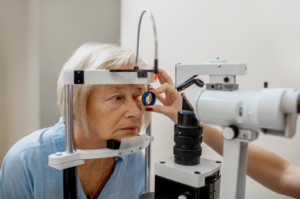 Whether you were recently diagnosed with mild-to-moderate glaucoma, or have been managing the condition for years, it is important to take control of your eye health by taking the necessary steps toward treatment. No matter how old you are when diagnosed, glaucoma requires lifelong treatment and monitoring.
Whether you were recently diagnosed with mild-to-moderate glaucoma, or have been managing the condition for years, it is important to take control of your eye health by taking the necessary steps toward treatment. No matter how old you are when diagnosed, glaucoma requires lifelong treatment and monitoring.
In this blog, we’re sharing some tips, including being aware of certain symptoms, knowing your treatment options, finding a physician treating your condition, and keeping up with yearly eye exams.
Find a Glaucoma Treatment That is Right for You
If you have been diagnosed with glaucoma, starting treatment immediately may reduce pressure in your eye and stop the disease from progressing. While there is not one specific treatment that will work for everyone with mild-to-moderate glaucoma, there are several options available. These may include:
Prescription eye drops: One common treatment for elevated eye pressure and glaucoma is prescription eye drops. When taken as directed, glaucoma eye drops can reduce this pressure by decreasing the amount of fluid from the eye.
- Laser treatments: There are several types of laser treatments available to treat glaucoma. With these treatments, a laser is aimed through a special lens to make microscopic changes that help fluid drain from your eye.
- Micro-Invasive Glaucoma Surgery: Micro-invasive surgical options are available for those who are interested in effective glaucoma management without having to rely solely on the continuous use of prescription medication. Specifically, iStent inject® W is designed to effectively lower eye pressure in those with mild-to-moderate primary open-angle glaucoma in conjunction with cataract surgery. This FDA-approved treatment is one of the smallest medical implants known to be implanted in the human body; it works continuously to reduce eye pressure, and it may reduce the number of glaucoma medications needed, at your physician’s discretion.
Watch for Additional Glaucoma Symptoms
Glaucoma can be difficult to identify because often there aren’t distinct symptoms that indicate someone is living with this condition. A person might not have any symptoms until he or she begins to lose a significant amount of vision, which typically happens slowly over time.

If you have already been diagnosed with glaucoma, it’s important to watch for any vision changes or symptoms that are out of the ordinary. This may indicate your current treatment options are not working or that your condition is progressing. Make an appointment with your eye care professional if you experience any of the following:
- Severe pain in the eyes or forehead
- Redness of the eye
- Decreased vision or blurred vision
- Seeing rainbows or halos around lights
- Headaches (on the same side of the affected eye)
- Nausea or vomiting
Understanding Glaucoma Risk Factors
When it comes to glaucoma, anyone can develop the condition. That being said, there are certain risk factors associated with the condition. Even if you’ve already been diagnosed with glaucoma, being aware of risk factors for the disease can help raise awareness if someone you know falls into those categories.
Open-angle glaucoma is partly hereditary, which means if an immediate family member has glaucoma, there is a much greater risk of developing the condition than the general population. A family history of glaucoma can increase your risk by four to nine times. It’s important to share information about the condition with your family and talk about risk factors for the condition so that they can get checked.
Another major risk factor is increased intraocular pressure, which occurs when fluid in the eye – used to transport important nutrients to the lens and cornea – accumulates and cannot drain naturally. Other risk factors of glaucoma include:
- Older age
- African American, Hispanic, or Asian ethnicity
- Familial history
- Thin corneas
- Blunt eye trauma
- Inflammatory eye conditions
The American Academy of Ophthalmology recommends getting a comprehensive eye exam at the following intervals, depending on your age group:
- Every five to 10 years if you are under the age of 40
- Every two to four years if you are between the ages of 40 and 54
- Every one to three years if you are between the ages of 55 and 64
- Every one to two years if you are 65 years old and older
However, if you are at higher risk for glaucoma or other vision-related conditions, you may need more frequent screening. Medical plans typically provide insurance coverage for a standard vision exam every two years, so don’t hesitate to make an appointment if you think something is off with your vision. Talk to your doctor about what is the right screening schedule for you.
Keep up with Regular Eye Exams
If you are currently living with glaucoma, it is important to keep up routine eye appointments. Glaucoma is a progressive eye disease, so the longer it’s left untreated, the greater the possibility of visual impairment. Once vision is lost due to glaucoma, it cannot be regained. If you have glaucoma, regular dilated eye exams monitor your condition, check eye pressure, and ensure that your treatment is doing its job.
Discuss with your doctor how often you should have your eyes checked. Since glaucoma is hereditary, encourage your family members to keep up with their eye exams, too.
 Find a Doctor and Take Control Today
Find a Doctor and Take Control Today
Understanding your condition and determining the best glaucoma treatment option for you begins by talking to your eye care professional. An ophthalmologist can give you a clear and specific understanding of your treatment needs. Together, you’ll be able to come up with a plan to manage your condition. With an ophthalmologist by your side and a treatment plan ahead, you will feel empowered and in control of your glaucoma journey.
If you’re looking for an eye care professional in your area who is familiar with treating mild-to-moderate glaucoma, use our physician locator today! Also, don’t forget to follow Living with Glaucoma on Twitter, Facebook, and Instagram.
PM-US-1074

 Prescription eye drops
Prescription eye drops Find a Doctor and Take Control Today
Find a Doctor and Take Control Today 

